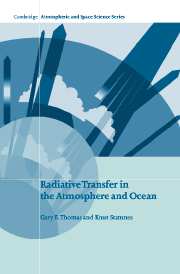Book contents
- Frontmatter
- Contents
- List of Illustrations
- Preface
- Acknowledgments
- Chapter 1 Basic Properties of Radiation, Atmospheres, and Oceans
- Chapter 2 Basic State Variables and the Radiative Transfer Equation
- Chapter 3 Basic Scattering Processes
- Chapter 4 Absorption by Solid, Aqueous, and Gaseous Media
- Chapter 5 Principles of Radiative Transfer
- Chapter 6 Formulation of Radiative Transfer Problems
- Chapter 7 Approximate Solutions of Prototype Problems
- Chapter 8 Accurate Numerical Solutions of Prototype Problems
- Chapter 9 Shortwave Radiative Transfer
- Chapter 10 Transmission in Spectrally Complex Media
- Chapter 11 Radiative Transfer in Nongray Media
- Chapter 12 The Role of Radiation in Climate
- Appendices
- Index
Chapter 12 - The Role of Radiation in Climate
Published online by Cambridge University Press: 18 December 2009
- Frontmatter
- Contents
- List of Illustrations
- Preface
- Acknowledgments
- Chapter 1 Basic Properties of Radiation, Atmospheres, and Oceans
- Chapter 2 Basic State Variables and the Radiative Transfer Equation
- Chapter 3 Basic Scattering Processes
- Chapter 4 Absorption by Solid, Aqueous, and Gaseous Media
- Chapter 5 Principles of Radiative Transfer
- Chapter 6 Formulation of Radiative Transfer Problems
- Chapter 7 Approximate Solutions of Prototype Problems
- Chapter 8 Accurate Numerical Solutions of Prototype Problems
- Chapter 9 Shortwave Radiative Transfer
- Chapter 10 Transmission in Spectrally Complex Media
- Chapter 11 Radiative Transfer in Nongray Media
- Chapter 12 The Role of Radiation in Climate
- Appendices
- Index
Summary
Introduction
As mentioned in the previous chapter, there are several radiatively active molecules – the so-called greenhouse gases – that strongly absorb and emit infrared radiation and thereby trap radiative energy that would otherwise escape to space. The global warming issue is concerned with the effects enhanced abundances of these trace gases and changes in aerosol loading (due in part to human activities) and cloud cover may have on the overall radiative energy balance of the Earth and hence on climate.
The bulk of the Earth's atmosphere (99% by mass) consists of molecular nitrogen and oxygen, in the form of radiatively inactive homonuclear, diatomic molecules. Trace amounts of polyatomic molecules are responsible for atmospheric absorption and emission of radiation in several hundred thousands of individual spectral lines arising from rotational and vibrational transitions. Water vapor, carbon dioxide, and ozone are the main absorbers (and emitters) contributing to warming and cooling of the atmosphere and underlying surface. These gases warm our planet by absorbing radiation emitted by the surface; without them the Earth would be some 33°C colder than at present and therefore uninhabitable. Hence, the so-called greenhouse effect is very important for life itself. Other trace gases make smaller contributions to warming/cooling of the atmosphere and surface. Some have natural origins, while others are partially (like methane) or wholly (like the chlorofluorocarbons) anthropogenic.
Figure 12.1 is a schematic diagram of the significant components of the Earth's energy balance.
- Type
- Chapter
- Information
- Radiative Transfer in the Atmosphere and Ocean , pp. 438 - 480Publisher: Cambridge University PressPrint publication year: 1999

